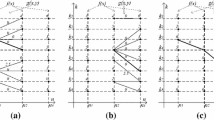Abstract
A new method of magnitude square coherence (MSC) estimation by an auto-regressive moving average (ARMA) model based on analytic discrete cosine transform (ADCT) and group delay (GD) property is proposed. The estimation is achieved by modeling the Welch-MSC derived from ADCT and the ARMA model realized by GD. The ADCT provides twice frequency resolution and reduced variance compared to those of conventional DFT. The proposed MSC estimate is superior to that based on MSC estimation using DFT, in terms of normalized sum of the sample mean square error (NSSMSE), maximum sample root-mean-square error and bias. The proposed method for the two examples involving two stationary stochastic processes reduces the NSSMSE by 60 and 30% over those of ARMA-MSC based on DFT. Further, the Welch-MSC based on ADCT itself reduces the performance indices over that based on DFT (significant for example-2). The proposed method is also applied to signals with sinusoids whose frequencies are located at off the DFT grid bin and closely spaced. The minimum variance distortionless response method of MSC estimation known for its frequency resolution fails to detect and resolve closely spaced off bin frequencies, whereas the proposed ADCT-based Welch-MSC and its ARMA detect and resolve those frequencies. The DFT-based Welch-MSC and its ARMA version though detect off the bin sinusoids, but due to their poor frequency resolution cannot resolve the closely spaced sinusoids. The average variance per frequency bin of ADCT-ARMA and DFT-ARMA is 0.0061 and 0.0108 (i.e., 43.52% reduction by ADCT), respectively.






Similar content being viewed by others
References
J. Benesty, J. Chen, Y. Huang, Estimation of the coherence function with the MVDR approach, in IEEE International Conference on Acoustics, Speech and Signal Processing (ASSP) (2006), pp. 500–503
R. Bortel, P. Sovka, EEG–EMG coherence enhancement. Signal Process. 86, 1737–1751 (2006)
J. Brynolfsson, M. Hansson-Sandsten, Multitaper estimation of the coherence spectrum in low SNR, in European Signal Processing Conference (EUSIPCO) (Portugal, 2014)
J.A. Cadzow, O.M. Solomon Jr., Linear modeling and coherence function. IEEE Trans. Acoust. Speech Signal Process. 35, 19–28 (1987)
G.C. Carter, C.H. Knapp, A.H. Nuttal, Estimation of magnitude square coherence function via overlapped FFT processing. IEEE Trans. ASSP 21, 337–343 (1973)
G.C. Carter, C.H. Knapp, Coherence and its estimation via the partitioned modified chirp-Z transform. IEEE Trans. Acoust. Speech Signal Process. 23, 257–264 (1975)
G.C. Carter, Receiver operating characteristics for a linearly threshold coherence estimation detector. IEEE Trans. Acoust. Speech Signal Process. 25, 90–92 (1977)
G.C. Carter, Coherence and time delay estimation. Proc. IEEE 75, 236–255 (1987)
Y.T. Chan, R.K. Miskowicz, Estimation of coherence and time delay with ARMA models. IEEE Trans. Acoust. Speech Signal Process. 32, 295–303 (1984)
J.W. Fay, Confidence bounds for signal-to-noise ratios from magnitude-squared coherence estimates. IEEE Trans. Acoust. Speech Signal Process. 28, 650–653 (1980)
J.M. Kates, K.H. Arehart, Coherence and the speech intelligibility index. J. Acoust. Soc. Am. 4, 2224–2237 (2005)
S.V. Narasimhan, G.R. Reddy, E.I. Plotkin, M.N.S. Swamy, Group delay based magnitude square coherence estimation by an ARMA model. Signal Process. 46, 285–296 (1995)
S.V. Narasimhan, M. Harish, Spectral estimation based on discrete cosine transform and modified group delay. Signal Process. 86, 1586–1596 (2006)
S. Roopa, S.V. Narasimhan, S-transform based on analytic discrete cosine transform for time–frequency analysis. Signal Process. 105, 207–215 (2014)
P. Sandeep, B.K. Shreyamsha Kumar, S.V. Narasimhan, 2D-spectral estimation based on DCT and modified magnitude group delay. Signal Image Video Process. 7(5), 959–973 (2013). doi:10.1007/s11760-011-0286-9
I. Santamaria, J. Via, Estimation of the magnitude squared coherence spectrum based on reduced-rank canonical coordinates, in Proceedings of IEEE International Conference on Acoustics, Speech and Signal Process (ASSP), vol. 3 (2007), pp. 985–988
K. Shi, G.T. Zhou, M. Viberg, Compensation for nonlinearity in a Hammerstein system using the coherence function with application to nonlinear acoustic echo cancellation. IEEE Trans. Signal Process. 55, 5853–5858 (2007)
S. Tiran, A. Dehbaoui, P. Maurine, Magnitude Squared Coherence based SCA, in 11th International Conference on Smart Card Research and Advanced Applications (CARDIS) (2012), pp. 234–247
N. Yousefian, C.P. Loizou, A dual-microphone speech enhancement algorithm based on the coherence function. IEEE Trans. Audio Speech Lang. Process. 20, 599–609 (2012)
C. Zheng, M. Zhou, X. Li, On the relationship of non-parametric methods for coherence function estimation. Signal Process. 88, 2863–2867 (2008)
Author information
Authors and Affiliations
Corresponding author
Rights and permissions
About this article
Cite this article
Roopa, S., Narasimhan, S.V. Magnitude Square Coherence (MSC) Estimation via an ARMA Model Based on Analytic DCT and Group Delay. Circuits Syst Signal Process 37, 1203–1222 (2018). https://doi.org/10.1007/s00034-017-0601-y
Received:
Revised:
Accepted:
Published:
Issue Date:
DOI: https://doi.org/10.1007/s00034-017-0601-y




